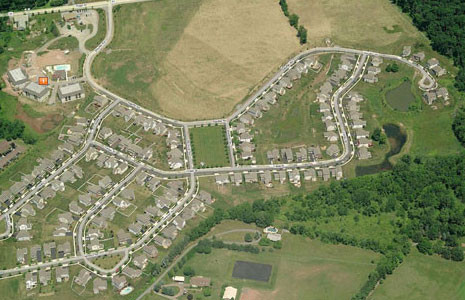

-
Place type
New Neighborhoods (directly related), Crossroads (partial related)
-
Location
Routes 401/100 at Ludwigs Corner, Chester County, Pennsylvania
-
Site
300 acres of undeveloped land, 65% of which remained open space after development.
-
Program
273 single-family and attached residences, 240,000 sq. ft. retail and office space, library.
-
Developer
Hankin Group
The rural Pennsylvania community of West Vincent Township has been using the planning process to help secure protection of a network of open space in its borders. Community members use open lands for economically productive purposes such as agricultural production and grazing, as well as maintaining forest habitats for animals and providing recreational opportunities. To guide the land preservation process, the township developed a map of potential conservation lands. The map identifies primary conservation areas (unbuildable wetlands, floodplains, and steep slopes, etc.) along with other opportunities for land preservation.
The property now containing the Weatherstone “village” development had been a subject of controversy for some time. It went through several proposed development scenarios before parties agreed to the current development scenario. The current development is a walkable conservation subdivision built with neo-traditional style streetscapes laid out in reference to the community’s land preservation and development map. Weatherstone’s development areas are located in those parts of the property that were indicated on the map as appropriate for development. The community includes small neighborhood parks, trails, and preserved natural areas and is served nearby by both bus and rail transportation.
Weatherstone contains many green infrastructure features that help maintain water quality and reduce the need for traditional infrastructure. It recharges groundwater supplies through the use of spray irrigation, in which fully treated wastewater is applied to conservation lands. Its stormwater management system features infiltration measures rather than more conventional “catch-and- release” approaches.